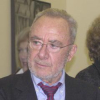Gerhard Richter

Gerhard Richter
Gerhard Richteris a German visual artist. Richter has produced abstract as well as photorealistic paintings, and also photographs and glass pieces. His art follows the examples of Picasso and Jean Arp in undermining the concept of the artist's obligation to maintain a single cohesive style...
NationalityGerman
ProfessionPainter
Date of Birth9 February 1932
CountryGermany
beautiful art pieces
It can be a work by Mondrian, a piece of music by Schönberg or Mozart, a painting by Leonardo, Barnett Newman or also Jackson Pollock. That's beautiful to me. But also nature. A person can be beautiful as well. And beauty is also defined as 'untouched'. Indeed, that's an ideal: that we humans are untouched and therefore beautiful.
art years ideas
A lot of different things had to come together over the years, accumulated experiences of a general and personal nature, before the idea and the decision were developed and then carried out.
art real mean
Art is not a substitute religion: it is a religion (in the true sense of the word: 'binding back', 'binding' to the unknowable, transcending reason, transcendent being). But the church is no longer adequate as a means of affording experience of the transcendental, and of making religion real - and so art has been transformed from a means into the sole provider of religion: which means religion itself.
art people effort
Almost every work of art is an analogy. When I make a representation of something, this too is an analogy to what exists; I make an effort to get a grip on the thing by depicting it. I prefer to steer clear of anything aesthetic, so as not to set obstacles in my own way and not to have the problem of people saying: 'Ah, yes, that's how he sees the world, that's his interpretation.'
art black-and-white two
Based on mixtures of the three primary colours, along with black and white, I come up with a certain number of possible colours and, by multiplying these by two or four, I obtain a definite number of colour fields that I multiply yet again by two, etc. But the complete realization of this project demands a great deal of time and work.
photography art drawing
Unlike the photography and prints, I never catalogued, kept track of or exhibited the sketches. I sold some occasionally, but never saw myself as a graphic artist. They became more important to me thanks to the exhibition, however, and I realized that these drawings were quite interesting after all.
beautiful art portraits
Of course, pictures of objects also have this transcendental side to them. Every object, being part of an ultimately incomprehensible world, also embodies that world; when represented in a picture, the object conveys this mystery all the more powerfully, the less of a 'function' the picture has. Hence, for instance, the growing fascination of many beautiful old portraits.
art mean thinking
If, while I'm painting, I distort or destroy a motif, it is not a planned or conscious act, but rather it has a different justification: I see the motif, the way I painted it, is somehow ugly or unbearable. Then I try to follow my feelings and make it attractive. And that means a process of painting, changing or destroying - for however long it takes - until I think it has improved. And I don't demand an explanation from myself as to why this is so.
knowing long leaving
Of course I constantly despair at my own incapacity, at the impossibility of ever accomplishing anything, of painting a valid, true picture or even knowing what such a thing ought to look like. But then I always have the hope that, if I persevere, it might one day happen. And this hope is nurtured every time something appears, a scattered, partial, initial hint of something which reminds me of what I long for, or which conveys a hint of it – although often enough I have been fooled by a momentary glimpse that then vanishes, leaving behind only the usual thing.
art real interesting
I find the Romantic period extraordinarily interesting. My landscapes have connections with Romanticism: at times I feel a real desire for, an attraction to, this period, and some of my pictures are a homage to Caspar David Friedrich.
reality abstract existence
Abstract pictures are fictive models, because they make visible a reality that we can neither see nor describe, but whose existence we can postulate.
important painting photograph
All photographs are far more important than any painting.
art play judging
Since there is no such thing as absolute rightness and truth, we always pursue the artificial, leading, human truth. We judge and make a truth that excludes other truths. Art plays a formative part in this manufacture of truth.
art numbers tree
I've never found anything to be lacking in a blurry canvas. Quite the contrary: you can see many more things in it than in a sharply focused image. A landscape painted with exactness forces you to see a determined number of clearly differentiated trees, while in a blurry canvas you can perceive as many trees as you want. The painting is more open.